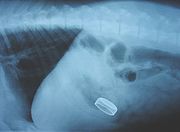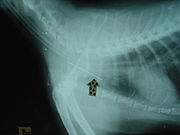
Foreign body
Encyclopedia
A foreign body is any object originating outside the body. In machinery, it can mean any unwanted intruding object.
Most references to foreign bodies involve propulsion through natural orifice
s into hollow organs.
Foreign bodies can be inert or irritating. If they irritate they will cause inflammation
and scar
ring. They can bring infection
into the body or acquire infectious agents and protect them from the body's immune defenses
. They can obstruct passageways either by their size or by the scarring they cause. Some can be toxic
.
Both children and adults experience problems caused by foreign objects getting stuck in their bodies. Young children, in particular, are naturally curious and may intentionally put shiny objects, such as coins or button batteries, into their mouths. They also like to stick things in their ears and up their noses. The effect of a foreign body can very different. For example, a coin causes local pressure on the tissue but generally, is not a medical emergency to remove. A button battery, which can be a very similar size to a coin, generates hydroxide ions at the anode and causes a chemical burn in 2 hours. An ingested button battery that is stuck in the esophagus is a medical emergency.
It is possible for foreign bodies to enter the tract from the mouth, or from the rectum.
In one study, peanut
s were the most common obstruction.. In addition to peanuts, hot dogs, and grapes, latex balloons are also a serious choking hazard in children that can result in death. A latex balloon will conform to the shape of the trachea, blocking the airway and making it difficult to expel with the Heimlich maneuver.
which are either temporary or even turn into a chronic allergy. This is especially evident in the case of dust
particles.
It is also possible for larger objects to lodge in the eye. The most common cause of intraocular foreign bodies is hammering.
 With sufficient force (as in firing of bullet
With sufficient force (as in firing of bullet
s), a foreign body can become lodged into nearly any tissue. Splinters are common foreign bodies in skin. Staphylococcus aureus
infection often causes boils to form around them.
Tetanus
prophylaxis may be appropriate.
 Foreign bodies can also become lodged in other locations:
Foreign bodies can also become lodged in other locations:

 Foreign bodies are common in animals, especially dog
Foreign bodies are common in animals, especially dog
s and cat
s. Dogs will readily eat toys, bones, and any object that either has food on it or retains the odor of food. Unlike humans, dogs are susceptible to gastrointestinal obstruction due to their ability to swallow relatively large objects and pass them through the esophagus
. Foreign bodies most commonly become lodged in the stomach
because of the inability to pass through the pyloric sphincter, and in the jejunum
. Symptoms of gastrointestinal obstruction include vomiting, abdominal pain, and depression due to dehydration
. Peritonitis
results if either the stomach or intestine has ruptured. Foreign bodies in the stomach can sometimes be removed by endoscopic
retrieval or if necessary by gastrotomy. Foreign bodies in the jejunum are removed by enterotomy
.
Certain foreign bodies in animals are especially problematic. Bones or objects with sharp edges may cause tearing of the wall of the esophagus, stomach, or small intestine and lead to peritonitis. Pennies
swallowed in large numbers may cause zinc
poisoning, which in dogs leads to severe gastroenteritis
and hemolytic anemia
. Linear foreign bodies can especially be dangerous. A linear foreign body is usually a length of string or yarn with a larger object or clump of material at either end. One end is usually lodged in the stomach or proximal small intestine and the other end continues to travel through the intestines. The material becomes tightly stretched and the intestines may "accordion up" on themselves or be lacerated by it. This is especially common in cats who may enjoy playing with a ball of string or yarn. Sometimes the linear foreign body anchors in the mouth by catching under the tongue. Pantyhose is a common linear foreign body in dogs.
Most references to foreign bodies involve propulsion through natural orifice
Orifice
An orifice is any opening, mouth, hole or vent, as of a pipe, plate, or a body.* Body orifice* Orifice plate* Calibrated orifice* Nozzle* Back Orifice-See also:* Choked flow* Needle valve* Venturi effect* Flow measurement...
s into hollow organs.
Foreign bodies can be inert or irritating. If they irritate they will cause inflammation
Inflammation
Inflammation is part of the complex biological response of vascular tissues to harmful stimuli, such as pathogens, damaged cells, or irritants. Inflammation is a protective attempt by the organism to remove the injurious stimuli and to initiate the healing process...
and scar
Scar
Scars are areas of fibrous tissue that replace normal skin after injury. A scar results from the biological process of wound repair in the skin and other tissues of the body. Thus, scarring is a natural part of the healing process. With the exception of very minor lesions, every wound results in...
ring. They can bring infection
Infection
An infection is the colonization of a host organism by parasite species. Infecting parasites seek to use the host's resources to reproduce, often resulting in disease...
into the body or acquire infectious agents and protect them from the body's immune defenses
Immune system
An immune system is a system of biological structures and processes within an organism that protects against disease by identifying and killing pathogens and tumor cells. It detects a wide variety of agents, from viruses to parasitic worms, and needs to distinguish them from the organism's own...
. They can obstruct passageways either by their size or by the scarring they cause. Some can be toxic
Toxicity
Toxicity is the degree to which a substance can damage a living or non-living organisms. Toxicity can refer to the effect on a whole organism, such as an animal, bacterium, or plant, as well as the effect on a substructure of the organism, such as a cell or an organ , such as the liver...
.
Both children and adults experience problems caused by foreign objects getting stuck in their bodies. Young children, in particular, are naturally curious and may intentionally put shiny objects, such as coins or button batteries, into their mouths. They also like to stick things in their ears and up their noses. The effect of a foreign body can very different. For example, a coin causes local pressure on the tissue but generally, is not a medical emergency to remove. A button battery, which can be a very similar size to a coin, generates hydroxide ions at the anode and causes a chemical burn in 2 hours. An ingested button battery that is stuck in the esophagus is a medical emergency.
Alimentary tract
One of the most common locations for a foreign body is the alimentary tract.It is possible for foreign bodies to enter the tract from the mouth, or from the rectum.
Airways
It is also possible for a foreign body to enter the airways.In one study, peanut
Peanut
The peanut, or groundnut , is a species in the legume or "bean" family , so it is not a nut. The peanut was probably first cultivated in the valleys of Peru. It is an annual herbaceous plant growing tall...
s were the most common obstruction.. In addition to peanuts, hot dogs, and grapes, latex balloons are also a serious choking hazard in children that can result in death. A latex balloon will conform to the shape of the trachea, blocking the airway and making it difficult to expel with the Heimlich maneuver.
Eyes
Airborne particles can lodge in the eyes of people at any age. These foreign bodies often result in allergiesAllergy
An Allergy is a hypersensitivity disorder of the immune system. Allergic reactions occur when a person's immune system reacts to normally harmless substances in the environment. A substance that causes a reaction is called an allergen. These reactions are acquired, predictable, and rapid...
which are either temporary or even turn into a chronic allergy. This is especially evident in the case of dust
Dust
Dust consists of particles in the atmosphere that arise from various sources such as soil dust lifted up by wind , volcanic eruptions, and pollution...
particles.
It is also possible for larger objects to lodge in the eye. The most common cause of intraocular foreign bodies is hammering.
Skin/tissue

Bullet
A bullet is a projectile propelled by a firearm, sling, or air gun. Bullets do not normally contain explosives, but damage the intended target by impact and penetration...
s), a foreign body can become lodged into nearly any tissue. Splinters are common foreign bodies in skin. Staphylococcus aureus
Staphylococcus aureus
Staphylococcus aureus is a facultative anaerobic Gram-positive coccal bacterium. It is frequently found as part of the normal skin flora on the skin and nasal passages. It is estimated that 20% of the human population are long-term carriers of S. aureus. S. aureus is the most common species of...
infection often causes boils to form around them.
Tetanus
Tetanus
Tetanus is a medical condition characterized by a prolonged contraction of skeletal muscle fibers. The primary symptoms are caused by tetanospasmin, a neurotoxin produced by the Gram-positive, rod-shaped, obligate anaerobic bacterium Clostridium tetani...
prophylaxis may be appropriate.
Other

- earEarThe ear is the organ that detects sound. It not only receives sound, but also aids in balance and body position. The ear is part of the auditory system....
s - noseHuman noseThe visible part of the human nose is the protruding part of the face that bears the nostrils. The shape of the nose is determined by the ethmoid bone and the nasal septum, which consists mostly of cartilage and which separates the nostrils...
- vaginaVaginaThe vagina is a fibromuscular tubular tract leading from the uterus to the exterior of the body in female placental mammals and marsupials, or to the cloaca in female birds, monotremes, and some reptiles. Female insects and other invertebrates also have a vagina, which is the terminal part of the...
- urethra
- blood vessels
In other animals


Dog
The domestic dog is a domesticated form of the gray wolf, a member of the Canidae family of the order Carnivora. The term is used for both feral and pet varieties. The dog may have been the first animal to be domesticated, and has been the most widely kept working, hunting, and companion animal in...
s and cat
Cat
The cat , also known as the domestic cat or housecat to distinguish it from other felids and felines, is a small, usually furry, domesticated, carnivorous mammal that is valued by humans for its companionship and for its ability to hunt vermin and household pests...
s. Dogs will readily eat toys, bones, and any object that either has food on it or retains the odor of food. Unlike humans, dogs are susceptible to gastrointestinal obstruction due to their ability to swallow relatively large objects and pass them through the esophagus
Esophagus
The esophagus is an organ in vertebrates which consists of a muscular tube through which food passes from the pharynx to the stomach. During swallowing, food passes from the mouth through the pharynx into the esophagus and travels via peristalsis to the stomach...
. Foreign bodies most commonly become lodged in the stomach
Stomach
The stomach is a muscular, hollow, dilated part of the alimentary canal which functions as an important organ of the digestive tract in some animals, including vertebrates, echinoderms, insects , and molluscs. It is involved in the second phase of digestion, following mastication .The stomach is...
because of the inability to pass through the pyloric sphincter, and in the jejunum
Jejunum
The jejunum is the middle section of the small intestine in most higher vertebrates, including mammals, reptiles, and birds. In fish, the divisions of the small intestine are not as clear and the terms middle intestine or mid-gut may be used instead of jejunum.The jejunum lies between the duodenum...
. Symptoms of gastrointestinal obstruction include vomiting, abdominal pain, and depression due to dehydration
Dehydration
In physiology and medicine, dehydration is defined as the excessive loss of body fluid. It is literally the removal of water from an object; however, in physiological terms, it entails a deficiency of fluid within an organism...
. Peritonitis
Peritonitis
Peritonitis is an inflammation of the peritoneum, the serous membrane that lines part of the abdominal cavity and viscera. Peritonitis may be localised or generalised, and may result from infection or from a non-infectious process.-Abdominal pain and tenderness:The main manifestations of...
results if either the stomach or intestine has ruptured. Foreign bodies in the stomach can sometimes be removed by endoscopic
Endoscopy
Endoscopy means looking inside and typically refers to looking inside the body for medical reasons using an endoscope , an instrument used to examine the interior of a hollow organ or cavity of the body. Unlike most other medical imaging devices, endoscopes are inserted directly into the organ...
retrieval or if necessary by gastrotomy. Foreign bodies in the jejunum are removed by enterotomy
Enterotomy
Enterotomy, by definition, is the surgical incision into an intestine. It may be a complication of an abdominal surgery including exploratory laparotomies....
.
Certain foreign bodies in animals are especially problematic. Bones or objects with sharp edges may cause tearing of the wall of the esophagus, stomach, or small intestine and lead to peritonitis. Pennies
Penny
A penny is a coin or a type of currency used in several English-speaking countries. It is often the smallest denomination within a currency system.-Etymology:...
swallowed in large numbers may cause zinc
Zinc
Zinc , or spelter , is a metallic chemical element; it has the symbol Zn and atomic number 30. It is the first element in group 12 of the periodic table. Zinc is, in some respects, chemically similar to magnesium, because its ion is of similar size and its only common oxidation state is +2...
poisoning, which in dogs leads to severe gastroenteritis
Gastroenteritis
Gastroenteritis is marked by severe inflammation of the gastrointestinal tract involving both the stomach and small intestine resulting in acute diarrhea and vomiting. It can be transferred by contact with contaminated food and water...
and hemolytic anemia
Hemolytic anemia
Hemolytic anemia is a form of anemia due to hemolysis, the abnormal breakdown of red blood cells , either in the blood vessels or elsewhere in the human body . It has numerous possible causes, ranging from relatively harmless to life-threatening...
. Linear foreign bodies can especially be dangerous. A linear foreign body is usually a length of string or yarn with a larger object or clump of material at either end. One end is usually lodged in the stomach or proximal small intestine and the other end continues to travel through the intestines. The material becomes tightly stretched and the intestines may "accordion up" on themselves or be lacerated by it. This is especially common in cats who may enjoy playing with a ball of string or yarn. Sometimes the linear foreign body anchors in the mouth by catching under the tongue. Pantyhose is a common linear foreign body in dogs.
External links
- Case report of Foreign Body Ingestion. Clinical Cases and Images.
- The Susy Safe Project. A Surveillance System on Suffocation Injuries due to Foreign Bodies in European Children.

